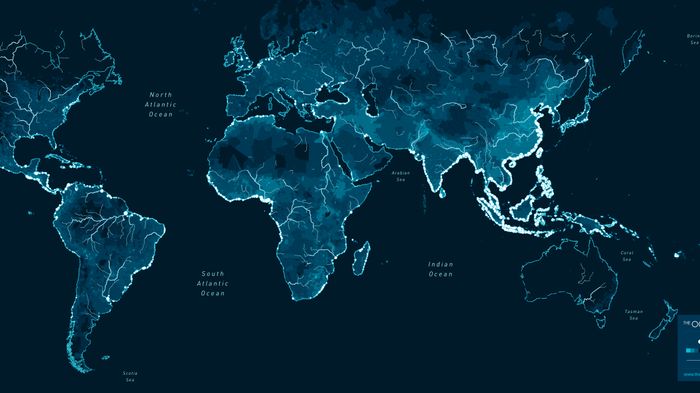
First Estimate to Quantify Global Plastic Input from Rivers into Oceans
Back to pressRivers annually emit between 1.15 and 2.41 million metric tons of plastic to the oceans.
DELFT, THE NETHERLANDS, June 7, 2017 – Researchers at The Ocean Cleanup, the Dutch foundation developing advanced technologies to rid the oceans of plastic, today published the first-ever estimate of plastic emissions from rivers into the world’s oceans. Writing in Nature Communications, they calculate that rivers annually transport between 1.15 and 2.41 million metric tons of plastic waste into our oceans. Two-thirds of this input comes from the 20 most polluting rivers, most of which are located on the Asian continent.
The distribution of plastic in the oceans can only be mapped if the main sources of plastic pollution are known. By pinpointing these sources, The Ocean Cleanup can target the best possible locations in the ocean for the deployment of its cleanup systems. Additionally, knowledge about the sources of plastic pollution can aid prevention efforts.
It is commonly accepted that most plastic found in the oceans originates from land-based sources. It is also well known that rivers play a particularly important role in transporting mismanaged plastic waste from land into the ocean. Until now, however, researchers had quantified neither the total amount of plastic flowing out of the world’s rivers nor how much plastic is emitted by each individual river. With today’s study, this information is now available.
For this study, a team led by The Ocean Cleanup researcher Laurent Lebreton created a model from the combined global geospatial information on: population density, waste management, topography, hydrography, and the locations of dams. After calibrating the model against field measurements of plastic flows from various rivers across the world, it was used to obtain a global picture of the annual river plastic emissions into the oceans.
Of the 40,760 ocean-bound rivers studied, just 20 are responsible for two-thirds of the global plastic input. In total, between 1.15 and 2.41 million metric tons of plastic are deposited into the oceans by rivers. The model also shows that plastic input from rivers is highly correlated with drainage of debris from the river banks and creeks leading into main waterways and that this river-to-ocean input, therefore, varies per season. Worldwide, three-quarters of the plastic released annually enter the oceans between May and October.
Boyan Slat, Founder and CEO of The Ocean Cleanup stated: “We’re pleased to see how many initiatives have been taken in the past few years to raise awareness of the ocean pollution problem. However, for our work in the deep ocean to succeed in the long run, it’s crucial that governments and other organizations speed up their efforts to mitigate the sources of the problem we aim to resolve. The results of this latest study can assist with those efforts.”
###
Note for the editors, not for publication.
PRESS CONTACT
CFF Communications
Jan van Ewijk / Claire Verhagen
press@theoceancleanup.com
T: +31(0)20 575 40 10
Photos and video footage supplementing this press release can be downloaded from theoceancleanup.com/media-gallery/
The full scientific publication in Nature Communications is open access and can be found on the journal’s website: https://www.nature.com/articles/ncomms15611
The results of the study have been processed in a model. A global interactive map of plastic inputs per river can be found here: theoceancleanup.com/sources
About The Ocean Cleanup
The Ocean Cleanup designs and develops advanced technologies to rid the oceans of plastic. Instead of going after the plastic – which would take many thousands of years and billions of dollars to complete – The Ocean Cleanup has developed a passive system which allows the ocean currents to concentrate the plastic itself. This will allow The Ocean Cleanup to remove 50% of the Great Pacific Garbage Patch in just 5 years.
Founded in 2013 by then 18-year-old Boyan Slat, The Ocean Cleanup now employs approximately 65 engineers and researchers. Since its inception, The Ocean Cleanup has raised 31.5 million USD in total funding. The foundation is headquartered in Delft, The Netherlands.
The Ocean Cleanup is developing a fleet of long floating barrier systems that each act as an artificial coastline, enabling the natural ocean currents to concentrate plastic debris. At the same time, The Ocean Cleanup is designing processes to convert recovered ocean plastic into valuable raw materials.
In preparation for full-scale deployment, The Ocean Cleanup organized several expeditions to map the plastic pollution problem in the Great Pacific Garbage Patch to an unprecedented degree of detail. Meanwhile, the team has advanced its design through a series of scale model tests, followed by a 100-meter prototype, that was deployed on the North Sea in June 2016. System trials off the American west coast will start by the end of 2017. The first deployment in the Great Pacific Garbage Patch is scheduled to take place in the first half of 2018.

